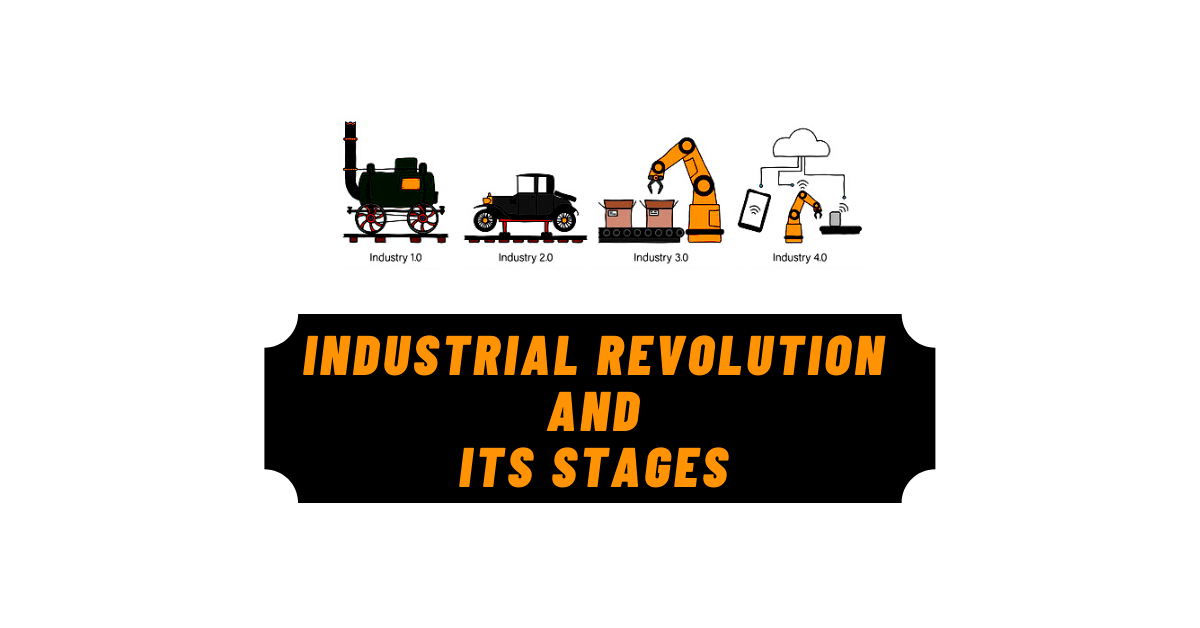Before discussing the Industrial Revolution and its stages, we must define it. The overall transformation transitioned from a handicraft economy to one controlled by industry and machine manufacturing.
It changed how we live, work, and connect with our economy. To manufacture every waking and sleeping second is the Industrial Revolution. We have electricity, drive a car, and our education and medicine are all products of the Industrial transformation.
This transformation was unlike anything humankind has ever experienced. Before the Industrial Revolution, people were usually farmers and worked in fields. However, the Industrial transformation saw a visible increase in production. This increase is due to machines that run on new energy sources.
Now, the question is, what were the four stages of the Industrial Revolution, and what will happen in the Fifth?
First Industrial Revolution
The Industrial Revolution began around the late 70s, starting in Europe, Britain. During this period, the processes focused on industrialization and product manufacturing. They used coal and steam-powered engines to mechanize production. These engines made possible railroads and even more efficient cotton mills. This innovation then enabled the large-scale manufacturing of goods and products like textiles. It also had an impact on people’s lives. They were no longer focusing on villages and farmers. People started to move to cities to work in factories, and urbanization took place.
Some Advantages of the First Industrial Revolution
- Factories and machines began to produce items faster and cheaper than by hand.
- Shoes, clothing, home products, tools, and other items that improve people’s lives grew more prevalent and less expensive.
- In foreign markets, the trade balance shifts in favor of the producer, resulting in increased wealth for the enterprises.
Second Industrial Revolution
The world experienced the Second Industrial Revolution about a century after the First. It began towards the end of the 19th century and started in the United States. This Industrial transformation ran on electricity, automobiles, and communication technologies. In this phase, Henry Ford initiated the concept of mass automobile manufacturing through assembly plant manufacturing, helping to emerge a new energy source: electricity, gas, and oil.
The discovery of the combustion engine occurred with the development of various fuel sources. During this time, both steel and chemical-based items entered the market. The telegraph, and later the telephone, accelerated advancements in communication technology. With the invention of vehicles, transportation advanced remarkably.
Some Advantages of the Second Industrial Revolution
- It was an era when industrial growth created a class of wealthy middle-class entrepreneurs.
- It would be impossible to communicate in the many ways we do now. The telephone, for example, was invented in 1876 by Alexander Graham Bell.
- It became much easier to get about during the Second Industrial Revolution, when the combustion engine, which now drives automobiles, was invented.
The Third Industrial Revolution
The Third Industrial Revolution began in the late 90s when another untapped energy source emerged.
Nuclear energy and electronics entered the landscape. Computers and digital systems allowed new ways of processing and sharing information. Mass manufacturing and miniaturization of transistors and microprocessors introduced technologies such as Robotics and Advanced Automation.
Electronics, telecommunications, and, of course, computers all emerged during the third revolution. Internet and mass communication also came into existence, eventually allowing the ultimate scale of globalization. We can now automate an entire production process – without human assistance. Known examples of this are robots that perform programmed sequences.
Fourth Industrial Revolution
Technologies with emerging physical, digital, and biological capabilities characterize the Fourth Industrial Revolution.
This era included the following advancements:
- Artificial Intelligence
- Machine Learning
- Cloud Computing
- Robots and Cobots
- Genomic editing
- Autonomous vehicles
- Big Data
- Blockchain
- 5G Network
- Quantum computers
- Internet of Things
AI and machine learning are understanding how machines act intelligently. These machines can learn from data, carry out responsibilities, and even predict future outcomes based on their knowledge of the data.
We use it daily, from Google searches to powering Amazon product recommendations and the personalized suggestions you get from Netflix and Spotify. It is also the foundation of which many other technologies. AI enables machines to carry out human-like tasks, such as facial recognition, chatbots, Alexa, etc.
Smartphones are the first smart device of many, and today, we also have smartwatches, TVs, and refrigerators. Everything is getting smarter—all thanks to IoT. It evolves at an exponential pace rather than a linear one. Moreover, it is disrupting almost everywhere around the globe. Economies around the world rely on it.
Fifth Industrial Revolution
We predict the Fifth Industrial Revolution will be an uprising in artificial intelligence, with the promise of quantum computation that will bring people and machines together in the workplace. Moreover, many believe that this industrial transformation bends the focus of technology toward humanity.
The 5th Industrial Revolution placed more emphasis on human intellect. Even now, AI helps recruiters find better profile encounters in the war on talent. This revolution offers tremendous advantages in providing applicants with a more personalized career experience.
According to an estimation, the Fifth Industrial Revolution could have prevented such instability. It would eliminate repetitive and tedious activities and help individuals and technology balance. It would open the door to curiosity, imagination, empathy, and judgment. Moreover, it is what we need through creativity and purpose. It would bend back the emphasis towards humans.
The world needs a Fifth Industrial Revolution. It will be marked by creativity and purpose as we strive together to bend growth and profits toward vision, diversity, and inclusion. We can create a socioeconomic era that eliminates historical inequities by taking revolutionary steps to improve the globe.
[Saad Aslam writes this article during Train the Learner’s four weeks Training Program as an Article Writer]




